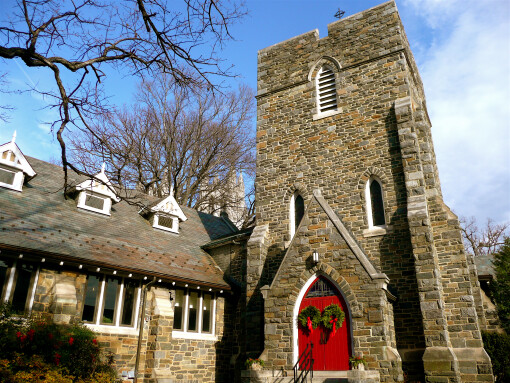What are we Afraid of?

Series: Pentecost
Speaker: The Rev'd Jim Quigley
When the Swineherds saw what had happened, they ran off and told it in the city and in the country. Then people came out to see what happened, and when they came to Jesus, they found the man from whom the demons had gone sitting at the feet of Jesus, clothed and in his right mind. And they were afraid.
That's the hinge point in this amazing and potentially liberating story. If in our hearing of it we get to those verses and ask ourselves something like Hmm, Why would they be afraid, or, What did they have to fear? we'd be asking the right questions.
When Jesus and his disciples crossed the sea of Galilee they left their familiar Jewish territory and arrived in the land of the Gerasenes. Among the Gerasenes there had been a man with a demon. No one knew what to do with this man, their own demons, so to speak, so the Gerasenes resigned him to their tombs chaining him to a rock. But he would break those chains and the demons would drive him to the wilds. Eventually the townspeople stopped trying to subdue him and simply let him live among their dead.
When seeing Jesus, the man under the control of the demons falls down, worships the son of the most high God, shouting at the top of his voice: What have you to do with me, Son of the most high God! I beg you, do not torment me!
Knowing the voice of the one supplicating, in response Jesus calmly asks, Whats your name? Legion, says the evil spirit, for we are many. And Legion begs Jesus not to not send him away into the abyss. We don't need to wonder why. Legion, or evil, wants to flourish. And evil can't flourish without a system, or a cycle, or a circumstance within which to operate. For Legion, as theologian James Allison puts it so well (Faith Beyond Resentment), is nothing more than the interrelationship of compulsions and driving forces that keep people together by enabling them to agree on having someone a scapegoat who represents what is not them, all that is dangerous, unsavory and evil... removed from the relationship between town and demoniac, Legion could have no existence.
In other words, Legions or we might say evils capacity for destruction, or for flourishing, is not something it possesses on it's own; Legion, or evil, can only flourish when inhabiting the broken or sinful human structures in the world. Legion needs a host. In the midst of the collapse of that host by the presence of Jesus, the collapse of the interrelationship of compulsions and driving forces that allowed the Gerasenes to identify as a group and to keep the demoniac as their necessary other, Jesus has left Legion with nowhere to go, or to be. And if you didn't notice, Jesus doesn't magically cast Legion into the swine, there's no sorcery here he just grants Legion permission to leave. They beg to go into the swine, and he lets them: "And then the demons came out of the man and entered the swine, and the herd rushed down the steep bank into the lake and was drowned".
And it's just then, when the story really takes hold. The Gerasenes get scared; the hinge point of the story. The system that has allowed evil or hatred to thrive, symbolically in the demoniac, a system that the Gerasenes somehow benefitted from and therefore perpetuated, had been undermined. And that's why they are afraid. Their future was uncertain. But the future always is uncertain, thanks be to God!
On this question, the question about why the Gerasenes were afraid, theologian James Allison is nothing short of brilliant. What was shocking [to them], Allison writes, was seeing [the former demoniac] sitting, clothed, and, even more perplexing, in his right mind. Their being afraid is only odd if we dont understand the dynamics of their story at all. Before, they had been in their right minds. Indeed, one of the things that kept them in their right minds was the comforting knowledge of one of their own who was not in his right mind. If the demoniac were not part of their fragile economy of group survival, they would of course had been pleased to have him returned to useful life among them. But it is as a demoniac that he was part of their economy, and they sensed it.
In his brilliance, Allison continues by positing that the townspeople probably had very little idea of why they were afraid, and maybe, we might add, what they were really afraid of. That what held them together, including their relationship with the demoniac, is at the level of what forms their consciousness, not something of which they are conscious, and so their way of being together was suddenly challenged.
We can easily conjure up current events here, can't we? The immigration debate, the need for a border wall, the refugee crisis? Our comforting ways of being together, as a country, in particular, as a world in particular, are being challenged. Black lives matter!
Whatever strange force it be, Allison writes, that has taken their demoniac outside the rules of the game by which [the Gerasenes] survive, [his freedom] is, they sense, terribly threatening. So, they are afraid, and they beg Jesus to leave. I'll admit that if Jesus were following me around every minute of the day, reminding me of what forms my consciousness, and of the privileges that I enjoy by virtue of my circumstances, most if not all of which I'm not entirely conscious of, things like white privilege, perhaps, I might be a little scared and beg Jesus to go away too. But at a deeper and more profound level, I'm reminded of some of what I experienced while on sabbatical in regard to the fears of the Afrikaners in the light of the end of the Apartheid or the fears of Zionists in the light of Palestinian liberation a fear that when liberated, the oppressed will become our oppressor. It's a legitimate fear.
Astonishing, isn't it? Astonishing that the evangelist we call Luke (and we should know that Luke couldn't tell this story without having first heard it from Mark), living and writing during the first century of the common era, knew what he knew about us, and about what we are afraid of. It's incredible to me that nearly two thousand years before systems theory would make its way into the field of psychology, or two hundred decades before mimetic theory would burst its way into the philosophies of anthropology, the social sciences and Christian theology, that these first-century evangelists, in a short little narrative, tell a story that illustrates and illuminates how were all trapped in systems that can control us, that societies have a need for scapegoats, and that our systems, whether personal, familial, political, or communal are highly resistant to change even when that change is necessary for the healing and wholeness of ourselves and of others. It's more than astonishing. It's revelatory.
And we could go on. Go on with what else this story holds for us I mean. We could marvel at why Jesus, at the end of the story, did in fact leave the Gerasenes, as they asked, rather than staying and preaching more about the good and upsetting news about what has to happen if Gods kingdom is to come. Of course he left them Jesus points us to the way??? As James Allison puts it, Jesus left them precisely because he didn't want to overwhelm this gentile town with what he knows to be a power that would completely destabilize them but he did plant a seed the oppressed one, freed from his bondage, would not become oppressor. The healed demoniac begs to remain with Jesus, but Jesus commends him: Return to your home, to the Gerasenes, and declare how much God has done for you. And that he did. Ultimately, the witness of the transformed Gerasene would be more powerful to that community than would be the witness of the Son of the most high God. (Truly I tell you, you will do greater works than these).
In our customary time of silence in response to the Gospel, we might pray that as we move closer and more devoted to God that we, in the midst of our Garasene fears, arent overwhelmed by a power that can, in fact, destabilize us. But we might also pray, as has oft been said, that God comfort the afflicted and afflict the comfortable, just a little bit, and then a little bit more. Help us Lord, to confront in ourselves all of which we are afraid, and let us pray: Heavenly Lord, so draw our hearts to you, so guide our minds, so fill our imaginations, so control our wills, that one day we will be wholly yours, utterly dedicated to you; and then use us we pray, as you will, and always to your glory and the welfare of all people, through Jesus Christ our Lord. Amen
 Welcome to St. Alban’s Church! Every Sunday, and most days in between, people gather in this place to worship, to learn, to grow, to share the joys and struggles of our lives, and to seek God’s grace in the midst of our lives. We do not come because we have it all figured out, but because we are seeking light on the way. We come as we are and welcome one another.
Welcome to St. Alban’s Church! Every Sunday, and most days in between, people gather in this place to worship, to learn, to grow, to share the joys and struggles of our lives, and to seek God’s grace in the midst of our lives. We do not come because we have it all figured out, but because we are seeking light on the way. We come as we are and welcome one another.

